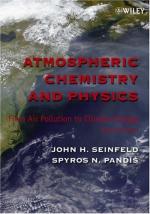|
This section contains 457 words (approx. 2 pages at 300 words per page) |

|
One of the exciting new fields of chemical research in the past half century involves chemical changes that take place in the atmosphere. Scientists have learned that a number of reactions are taking place in the atmosphere at all times. For example, oxygen (O2) molecules in the upper stratosphere absorb solar energy and are converted to ozone (O3). This ozone forms a layer that protects life on Earth by filtering out the harmful ultraviolet radiation in sunlight. Chlorofluorocarbons and other chlorinated solvents (e.g., carbon tetrachloride and methyl chloroform) generated by human activities also trigger chemical reactions in the upper atmosphere including the break up of ozone into the two-atom form of oxygen. This reaction depletes the earth's protective ozone layer.
Clouds are often an important locus for atmospheric chemical reactions. They provide an abundant supply of water molecules that act as the solvent required for...
|
This section contains 457 words (approx. 2 pages at 300 words per page) |

|


